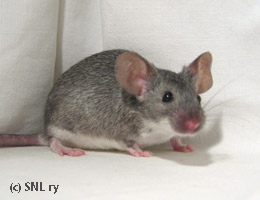Varieties
Ticked
Chinchilla (chi)
A/at B/* cch/cch D/* P/*, or
Aw/* B/* cch/cch D/* P/*
"The mouse shall be as near as possible to the colour of a chinchilla with slate-blue undercolour and intermediate shade of pearl-grey. Hairs to be evenly tipped with black. Colour of feet on inside white, with remainder of foot the same colour as body - as in the standard for tans. Belly white. Eyes black."
Breeding information below the pictures.
Quick Look
Chinchilla is a grey agouti with white belly colour. There are two ways to get the white belly; either white bellied agouti gene Aw or tan gene at.
Genetic Background and Other Info
As far as the A-locus is concerned, there are several possible combinations a chinchilla may have: Aw/Aw, Aw/A, Aw/at, Aw/a or A/at. The most desired one would be Aw/Aw as it enables the colour to breed true (i.e. mating chinchilla to chinchilla only produces chinchilla). All other A-locus allele combinations produce other varieties in addition to chinchilla.
Show type chinchillas in Finland originate from British imports in 2004. These were genetically Aw/Aw which means that nearly all chinchilla mice in Finland have the Aw gene, possibly in combination with some other A-locus allele. Genotype A/at is rare in show chinchillas. There are well established lines of chinchilla mice in Finland, so breeding stock should be available for someone interested in the variety.
The challenges in breeding chinchilla are the same as with grey agouti regarding the top colour: brownish shade, concentration of ticking and/or “muddy” ticking. Getting the belly colour as white and strong as possible produces another challenge. Molts may often hamper the show success of chinchilla mice. Female chinchillas may also lose the quality of their belly colour due to nursing or seasonal changes.
Possible varieties to breed together with chinchilla are argente crème or black fox. Especially argente crème works well with chinchilla in the same line, black fox with some precautions – frequent mixing with black fox may damage the ticking on chinchilla. Grey agouti works as an occasional outcross, but the first generation of offspring will have poor belly colour. As with grey agouti, the type of chinchilla may be improved by an outcross to show type pink eyed white. The colour genes to avoid are the same as with grey agouti.



